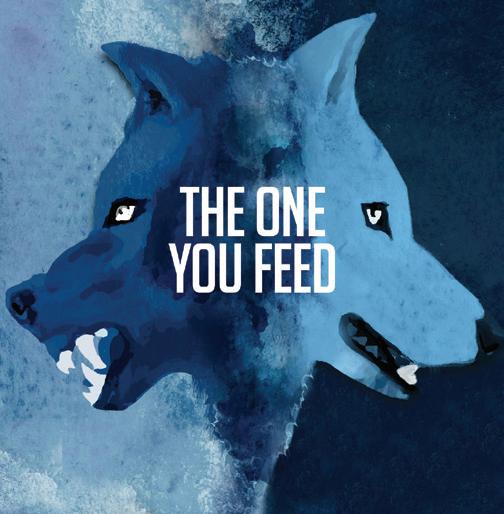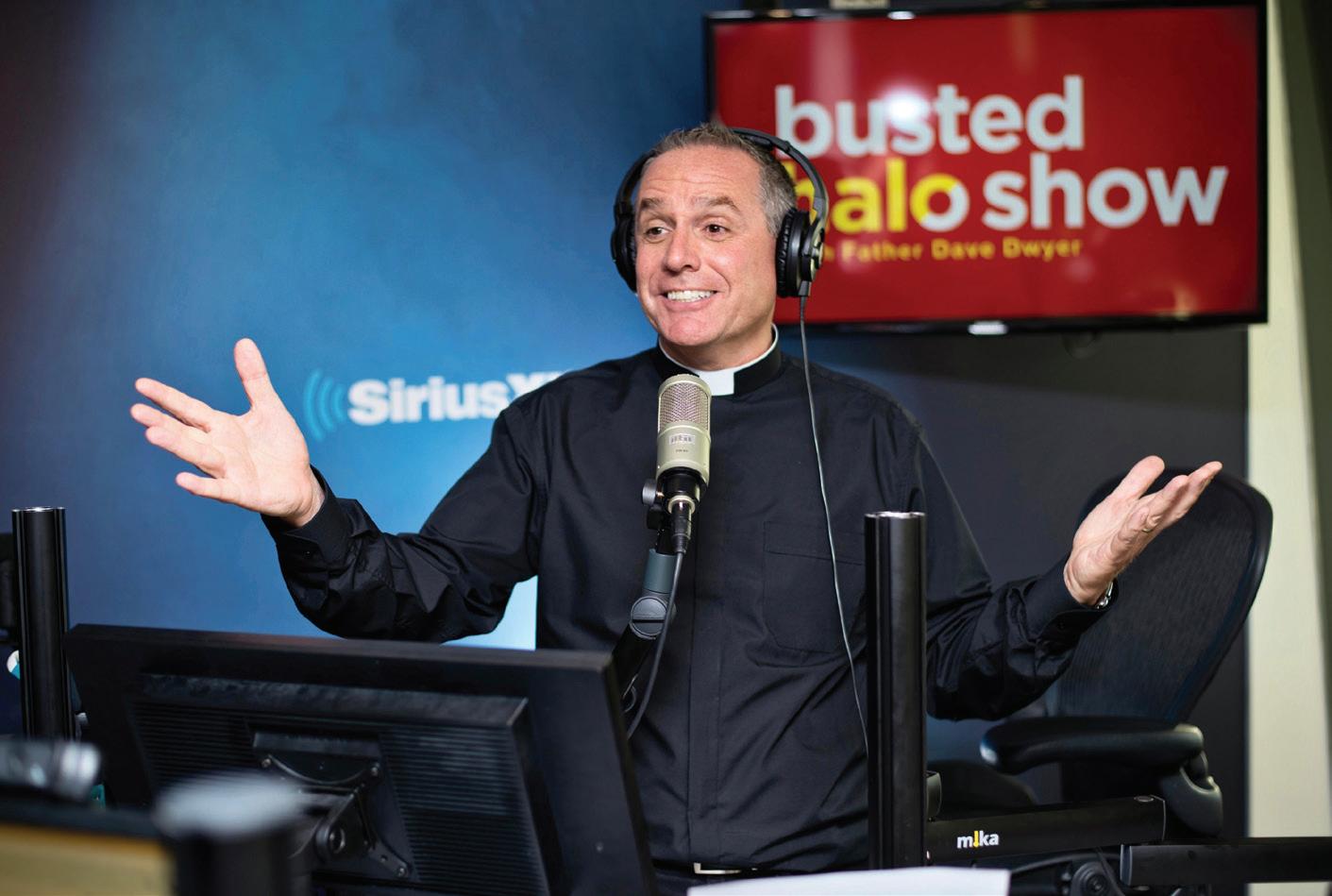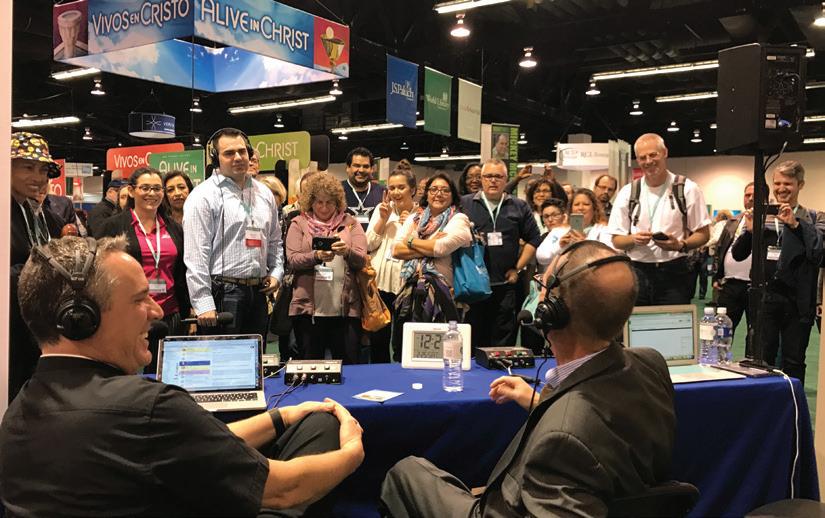
31 minute read
Teens: What They Want Us to Know
Adolescence is a tumultuous time. It’s easy to forget that, ultimately, teens just want to be acknowledged, listened to, and respected.
Like many teens I’ve worked with, I didn’t grow up in the most functional of families. I was born to a single mother who worked three or four jobs at any given point to make ends meet. Most nights she worked late. From the age of 13 onward, I spent many weeknights home alone in an empty house feeling lonely, sad, and angry. Of course, I couldn’t articulate that at 13, but I was hurting, and I wanted to make the hurt go away. I turned to food.
Advertisement
Every day, I would come home and try to eat things that made me feel better. And week by week, month by month, I needed more and more food to make me feel better. By the age of 15, I could no longer be weighed on my doctor’s scale, which maxed out at 350 pounds, and I was forced to be weighed on a scale at our local butcher shop. As I stood on the steel platform and watched the long red needle spin and land at 420, I murmured, “That can’t be right.” My mom, with tears in her eyes, assured me we would do something about my weight. We didn’t.
THE FEAR OF BEING INVISIBLE
Being a poor kid on scholarship at a private school was hard enough on its own. Being morbidly obese didn’t help. It felt as though I was picked on constantly. And the more I got teased the more I ate when I got home. By the time I was a senior in high school, I couldn’t fit in the desks in several of my classes; those that I did squeeze into left welts and bruises on my stomach and side. Wearing a 6X shirt and size 64-inch waist, now weighing 480 pounds, I was embarrassed to leave the house and almost never wanted to go to school.
Midway into my senior year a teacher pulled me aside and informed me that I was becoming obnoxious, which wasn’t like me, and he wondered what was going on. I had no idea what he was talking about. I told my mom, and she suggested that I be nicer to people. I didn’t realize I wasn’t being nice.
Today, I attribute that obnoxious attitude largely to my desire to be seen. At some point during high school, I stopped getting picked on. I went from being bullied to being ignored. As strange as it may sound, being harassed was preferable to feeling ignored. I was the biggest human being in my town, yet most days I felt like no one could see me. Unconsciously, I left behind Mr. Nice and ushered in Mr. Jerk. Mr. Nice was invisible. Mr. Jerk got me attention—negative attention, to be sure, but at least that was something. Rejection, contrary to what many suggest, is not our greatest fear: being invisible is. I’ve experienced in my own life and in the lives of teens I know that rejection is preferable to not feeling that you are seen. We need attention, especially during our formative years, and we’ll stop at nothing to get it—even if it means attracting negative attention.
People will get as big as it takes (through food or steroids), as thin as it takes, have as many piercings and tattoos as it takes, wear whatever hairstyle and clothing it takes, and act in whatever way necessary to receive attention. For teens, attention is like oxygen for the soul. And in the most unfortunate situations, they’ll take lives, including their own, so as to not feel invisible. It’s no wonder that as of this writing, suicide is the third leading cause of death for teenagers today. If I can’t be seen, then why should I be here at all?
SEEING THE WHOLE
Sometimes it’s not that teens feel totally invisible, as I did, but that they feel a certain part of themselves is not being seen. Such was the case with Stephen, a high school junior who, on paper, had every reason to be happy. He was a great athlete, and he had a wonderful personality and lots of friends. His parents were genuinely kind, warm, and delightful people—to which he would attest. On the surface, it didn’t make sense at all that this young man was depressed,
having suicidal thoughts, always irritable, and now verbally lashing out toward his parents.
When we first met for counseling, he was smiling and very friendly, which is rare in teens at the first session. We seemed to hit it off right away, and he didn’t hesitate to tell me that he hadn’t been feeling like himself lately. In fact, he wasn’t sure what that even felt like anymore. He was aware that he was losing his temper with his parents and starting to do the same with peers and teachers. But he couldn’t figure out why.
Just as I was about to bring the session to a close, with three minutes left, he said, “Oh, and I’m adopted.” I said nothing and just looked into his eyes. Knowing how important it is, for guys especially, not to feel overexposed too soon, I broke eye contact and asked, “What’s it like for you—being adopted?”
“It sucks!” he said harshly, as if I, the counselor, was an expert who should know that being adopted sucks.
“So,” I said, “for you being adopted is a really tough thing.”
“Yeah. It is,” he said and then stood up, smiled, shook my hand, and said while walking out the door, “See you next week, man.”
I began our second session by asking, “What was it like for you last time? When you left my office, what were you feeling? Thinking?”
“Well,” he paused, “I dunno. I mean, I guess it was good.”
“But what were you feeling when you left?” I asked.
“Oh . . . relieved, I think,” he said, looking away.
“What happened last time that made you feel relieved?” I asked.
Stephen paused and then said, “I think it was the way you looked at me when I told you I was adopted. I don’t know what I was expecting, but I’m always scared to tell people I’m adopted. Either they look at me like an orphan or they try to convince me that I’m better off than I could be, and that I should be grateful to have such wonderful parents and a wonderful life, considering my alternative. But you didn’t do that. You just looked at me for a while and asked what being adopted was like for me. That was cool.”
In the following weeks and months, Stephen shared with me how he was picked on as a kid for being adopted. He would cringe as he recounted stories of kids in middle school calling him a “redhead orphan.” Stephen allowed me to walk with him toward healing those painful wounds because in our first visit he experienced me seeing a part of him that others did not, but a part he wished they would. Even though he was aware of his many blessings and grateful for much of his current life, there was a part of him that felt neglected, unworthy, and unwanted.
A WITNESS TO PAIN
In Sue Monk Kidd’s novel The Secret Life of Bees, August Boatwright, a woman who farms bees for honey, takes in Lily, a girl who has run away from her abusive single father.
“Sure people see me, but they don’t really ‘see’ me. They see parts of me: the athlete, the guy who likes to party, the stud who gets the girls. They don’t see the depressed kid who hates his life, who feels pressured into living up to a reputation he created, and the part of me that’s scared to death of someone finding out about these ‘other’ parts of me.” —High school junior

“Youth need our appreciative gaze; mostly, they simply need our gaze. One of the deepest hungers inside young people is the hunger for adult connection, the desire to be recognized, seen, by a significant adult. They desperately need, and badly want, the blessing that comes from our gaze and presence. They need for us to see them. In the end, more than they want our words, they want our gaze.” —Ronald Rolheiser, OMI
Lily soon discovers that, ironically, this was the same place her mother ended up when she left Lily’s dad years ago. Lily struggles to understand why her mom would leave her, and August suggests that when people are hurting, they need to leave the situation they believe is hurting them. Lily responds, “Was it the wounded places down inside people that sought each other out, that bred a kind of love between them?” August responds, “But it’s something everybody wants—for someone to see the hurt done to them and set it down like it matters.”
Teens need us to see their pain, even if there has been no perceived harm done to them. It may be that they experienced a particular situation as painful or that there was a relationship or time in their life that caused them hurt. During these times, what they need most is not someone’s logical explanation of how they see the situation, but validation. Rather than making the person feel like a victim, this validation legitimizes their experience and shines the light of hope into their darkness. It offers meaning to what would otherwise feel like a random, possibly sadistic experience.
Mark’s account of Jesus’ interaction with a wealthy young man reads, “Jesus, looking at him, loved him” (10:21). Jesus made it a point to see that young man, and in so doing loved him in such a powerful way. The French word used in this passage is regarder, a verb that means “to watch.” In my personal Bible, I’ve written the word regarding over the words looking at in this passage. It says a bit more. It speaks of a respectful, attentive look. In fact, when we don’t feel respected and attended to, we use the word disregarded. I often wonder what the young man felt as Jesus gazed at him.
BEYOND THE FACADE
When I was 19, I believe I experienced that gaze. By my second year of college, I was weighing in at over 500 pounds. One day, bribing me with hot donuts, some friends persuaded me to visit the Catholic student center on campus. While I was sitting on a sofa eating donuts right out of the box, a Catholic priest walked up to me and introduced himself. At that point, I hadn’t darkened the door of a church
Home & Away... Help is on the way!
MobileHelp is the premier Medical Alert System that provides emergency coverage inside your home and throughout the USA.
To get Life Saving Information and a
FREE BROCHURE, call MobileHelp today!
• No equipment to buy. • Sign up in minutes. Activation is simple. • No long term contract.
Call for a FREE Brochure! 1-855-645-5701

FREE GIFT W/PURCHASE
Optional Fall Button ™ with Automatic Fall Detect
Comfortable and lightweight ■ Signals for help even when you can’t press your button*
MobileHelp Exclusive Offer
FREE Emergency Key Holder
Get your free Emergency Key Holder when you purchase a MobileHelp service plan. Offer valid while supplies last.
$ 2 9 9 5 VA L U E !
*Service availability and access/coverage on the AT&T network is not available everywhere and at all times. Fall Button™ does not detect 100% of falls. If able, users should always push their help button when they need assistance. Fall Button™ is not intended to replace a caregiver for users dealing with serious health issues. Current GPS location may not always be available in every situation. MobileHelp is a registered trademark and Fall Button is a trademark of MobileHelp. Patented technology. MobileHelp is an FDA registered company. MHP-06631A
Prayer to Help Us Connect with Teenagers
Lord, help us to really see deep into the hearts of teens, in the same way you search and probe our own hearts. Give us the grace to want to see you and your Spirit as you dwell within each of the teens in my life. Amen.

in five years, and I dreaded conversing with a man of the cloth. I didn’t want to give him my spiritual résumé or have to lie to him if he asked me about going to Mass when I had no intention of doing so.
The priest looked deep into my eyes and smiled in a way that no one had ever smiled at me before. Instead of asking me to attend Mass, he invited me to lunch. After that lunch, he invited me to another, and another. At least once a week throughout the fall and spring semesters, he invited me to spend time with him, usually at a local pizzeria sharing its signature meat pizza called the “T-Rex.” I remember feeling, “This guy doesn’t seem to notice that I’m obese and poor.”
Today I realize that he did notice, but that didn’t throw him off, because he saw something deeper in me. When I was a 500-pound 19-year-old, he saw the 220-pound, healthy husband and father who is writing this. He saw the entrepreneur, the minister I could and would grow to become. He saw me.
The way he saw me affected the way he treated me, and the way he treated me drastically affected the course of my life. I can say without question that I am who I am and where I am today as a direct result of being truly seen by him and by a few others at the Catholic student center. How we see others matters.
The young man in the Gospel ultimately walks away sad because he has many possessions. I’ve read and heard interpretations of this Gospel story that assume the young man spent the rest of his life off-track, that he left Jesus with no intention of ever doing what Jesus asked—“Sell what you have, and give to

the poor and you will have treasure in heaven; then come, follow me” (Mk 10:21).
Since the details of what happens to the young man after he leaves, disappointed in Jesus’ answer, are not known, I’d like to think that at some point in his life, the man was touched by the way Jesus saw him and did indeed turn his life over to Christ.
TO BE KNOWN AND UNDERSTOOD
Times have changed, and teens in some very important respects are different than I was as a teen—as you were as a teen. But that desire to be seen remains constant. The experience of being seen by another is a powerful form of intimacy. Deep inside each of us, at every point in our lives, but most especially during the turbulent period of adolescence, we need to be seen.
Teens need to see themselves through the eyes of significant others. When this happens, we feel known, understood in some way. This is especially important for teens who have been wounded. What may seem like a distrust of others is usually matched by an equal desire to be really seen.
This article is adapted from What Teens Want You to Know (but Won’t Tell You), by Roy Petitfils (Franciscan Media).
Roy Petitfils is a licensed counselor at Pax Renewal Center in Lafayette, Louisiana. He studied ministry and spirituality at the Pontifical University of St. Thomas Aquinas and holds a master’s degree in mental health counseling from the University of Louisiana. He and his wife, Mindi, live in Youngsville, Louisiana, with their two sons, Max and Benjamin. Learn more about his work at RoyPetitfils.com.
Practical Tips for ‘Seeing’ Teens

BE AWARE OF YOUR ASSUMPTIONS. As much as possible, begin every interaction with an open mind. This is not easy, but it’s difficult to see the reality of the young person in front of us when our vision is blurred by our preconceptions and assumptions. Adolescence is a time of rapid change on every level. When I was teaching in the classroom, every day I had a note on my desk that read, “These are not the same kids that were here yesterday; get to know these kids.”
MAKE AND KEEP EYE CONTACT. I know, it sounds too simple actually to be effective, but I’ve found this to be a very useful tool in counseling, mentoring, and parenting. The reason it’s so effective, especially today, is that many teens spend their days looking into their smartphones, tablets, computers, and the like. The amount of real eye contact they experience is minimal. So when you do engage with teenagers in this way, it has an impact on the person, even if only unconsciously.
SMILE. The majority of teens today are wary of adults. They don’t necessarily assume that we’re mean or out to get them; they just don’t tend to trust us. A genuine smile tells them we’re not the enemy. It also tells them they are someone worth smiling at.
ASK OPEN-ENDED QUESTIONS AND LISTEN. Even if their answers are brief or they act a little weird about this, it is usually because they are nervous. But teenagers like the attention and appreciate your effort to let them know you care about what they think. When we make a habit of asking them questions and then patiently listening to them while they answer, teens feel seen. They experience this as us focusing on them in a positive way, and it contributes to their positive self-esteem. It’s another opportunity to build trust and a pathway for open communication.
To order a copy, go to: Shop.FranciscanMedia.org. For 25% off, use code: SAMteens
One solution for oxygen at home, away, and for travel
Introducing the INOGEN ONE It’s oxygen therapy on your terms

No more tanks to re ll. No more deliveries. No more hassles with travel. The INOGEN ONE portable oxygen concentrator is designed to provide unparalleled freedom for oxygen therapy users. It’s small, lightweight, clinically proven for stationary and portable use, during the day and at night, and can go virtually
anywhere — even on
most airlines. Inogen accepts Medicare and many private insurances!
Reclaim Your Freedom And Independence NOW!
Call Inogen Today To Request Your FREE Info Kit


1-855-765-2954
A 100-year-old cottonwood tree at the Center for Action and Contemplation in Albuquerque, New Mexico, has continually inspired the center’s founder, Richard Rohr, OFM, to meditate on life’s interconnectedness.
Amid growing calls for meaningful digital resources, these media ministries are responding daily with content that feeds the soul.
Spiritual Nourishment in a Digital World

By Daniel Imwalle and Christopher Heffron
Just as uplifting news stories seem to get buried under the more salacious and exploitative items, the efforts to spread goodness and well-being via technology are often overshadowed by mind-numbing games and unhealthy use of social media. Although we ought to tread carefully in the web-based world of content, we should also keep an open mind to where it can be beneficial to our psyches and spirits. Indeed, Pope Francis, though cautious, was optimistic when he stated that “a better world is possible thanks to technological progress, if this is accompanied by an ethic inspired by a vision of the common good, an ethic of freedom, responsibility, and fraternity, capable of fostering the full development of people in relation to others and to the whole of creation” (audience at the Vatican, September 2019).
There is a growing wave of people who are seeking more from their experience with digital media, something that connects them to faith, meaning, and healthier relationships. To meet this need, apps, podcasts, YouTube channels, blogs, and many other virtual spaces are springing up—so many, in fact, that it’s getting to be somewhat of a challenge to know where to start. To help you navigate this ever-changing digital landscape, here are six examples of the emerging presence of meaningful media.
Father Richard Rohr has found a famous friend in Oprah Winfrey. The two discussed his book The Universal Christ on Oprah’s SuperSoul Conversations.

THE CENTER FOR ACTION AND CONTEMPLATION
The brainchild of Richard Rohr, OFM, the Center for Action and Contemplation (CAC) strives to enrich the lives of spiritual seekers by striking a balance between healthy introspection and outward expressions of responding to the Gospel call. Not long after moving to Albuquerque, New Mexico, Father Richard established the CAC in 1986.
Popular events such as CONSPIRE—an in-depth, threeday conference on contemplative living—and the two-year Living School program have attracted thousands of participants interested in the center’s inclusive and welcoming ministry.
THE ONE YOU FEED
It all started with a parable. In it, a grandfather tells his grandson about the two wolves that are in a constant struggle within us—one that represents kindness, bravery, and love, and another that represents greed, hatred, and fear. The grandson asks which wolf will win the battle, and his grandfather responds, “The one you feed.” This parable is central to the ethos of the website and podcast named after the grandfather’s answer to his grandson.
Eric Zimmer, a life coach and author, certainly knows what it’s like to feed the wrong wolf. When he was 24, he was homeless, addicted to heroin, and facing serious legal consequences if he didn’t make a bold move to start being the best version of himself. For the past 20 years, Zimmer has fine-tuned his approach to behavior modification, coupling ancient wisdom with cutting-edge cognitive behavioral therapy techniques to help people reframe their internal monologue in a positive light.
The One You Feed podcast is a weekly offering and the flagship of Zimmer’s efforts. The podcast, which numbers over 300 episodes, has more than 13 million downloads and was listed on Oprah’s list of “22 Podcasts That Will Motivate You to Live Your Best Life.” Although the podcast covers a wide range of topics related to well-being, most of the content falls within four main areas: anxiety and depression,
Calling to mind Jesus’ 40 days in the desert, the location seems a fitting backdrop for an institution focused on mindfulness and soul-searching. And, again mirroring the life of Christ, whose ministry followed his time of self-discovery in the desert, the CAC encourages those who engage with its content to apply what is gained through contemplation back in the “real world.” According to the center’s website, their mission is to “open the door for a critical mass of spiritual seekers to experience the transformative wisdom of the Christian contemplative tradition and nurture its emergence in service to the healing of our world.”
Although visiting the CAC in person for its many retreats and seminars remains a popular draw, it has increasingly offered a variety of resources online. Four podcasts, e-learning courses, daily e-mail meditations from Father Richard, and an online bookstore are just a few of the items on the CAC website. One of the podcasts, Another Name for Everything, features weekly conversations between Father Richard and the two hosts, Brie Stoner and Paul Swanson, on a plethora of topics that unpack the concept of contemplative living.
Ever in tune with the times, Another Name for Everything doesn’t shy away from addressing current issues, such as living out our faith in an era of globalization and practicing mindfulness during the coronavirus pandemic. In a fast-paced culture that is increasingly fixated on immediate results, the CAC is an oasis of calm for the world-weary.
cac.org addiction and recovery, habits and behavior change, and meditation and mindfulness.
Beyond the podcast, the website features a blog, two programs that drill down into Zimmer’s approach to self-improvement (the Spiritual Habits and Personal Transformation programs), and “Eric’s Bookshelf,” a list of both fiction and nonfiction titles that have been formative to Zimmer’s own personal growth. For those hungry for a life lived with more intentionality, The One You Feed is there to nurture the good wolf in us. OneYouFeed.net
Eric Zimmer left, lived a hard life on the streets before becoming a successful life coach and podcast host.


Catholic women looking for fellowship and a shared love for the faith would be wise to check out Blessed Is She, a collective of talented female writers who seek to build community through writing.

BLESSED IS SHE
“Blessed is She is a sisterhood who desires two things: prayer + community. If that sounds up your alley, we’re so glad you’re here.” Site visitors are met with this warm salutation straight away—and that inclusive tone is used throughout this unique online experience. Founded by Jenna Guizar in the Diocese of Phoenix, Arizona, Blessed Is She is a collective of dedicated female Catholic writers with the noble mission to share their love for the Catholic faith with like-minded women.
The Blessed Is She site is admirably simple—and attractively designed. Visitors can

engage with their blogs and devotionals, and shop for gifts to feed the spirit. One blog in particular was both timely and relevant, “Tips for Attending Mass from Home with Kids.” Published during the start of the COVID-19 pandemic, author Valerie Keinsley offered these sage words for parents on lockdown: “Nothing about this is normal or easy, and that’s okay. Pausing the live-stream to redirect rambunctious kids, adjusting your usual Sunday traditions, and longing for in-person community and fellowship are all going to take a lot of patience and flexibility on everyone’s parts. Pray for the patience to continue to adapt as this current crisis evolves, and trust that God provides everything you need.”
Providing faith-based tips for navigating life’s peaks and valleys is in abundance in their ministry and on their site.
“You belong here”: These three words can be found on their “About Us” page. Blessed Is She welcomes weary seekers to visit, get comfortable, and be inspired to celebrate the richness of the Catholic faith. To those in need of community and spiritual nourishment, welcome home. BlessedIsShe.net
LIFE TEEN
One of Life Teen’s missions is to bring teens closer to Christ with the Blessed Virgin Mary as their intercessor and guide. Interesting enough, but nowhere in their “About Us” page does it boast their strongest asset for such a noble mission: Mark Hart. As the CIO and executive vice president of Life Teen,

LEFT: Mark Hart is the CIO and executive vice president of Life Teen, a Catholic youth ministry organization. Their mission: to bring teens closer to Christ.
Life Teen understands that young Catholics are a powerful, vocal force within the worldwide Church. Their content brings the Spirit to life for Catholic teens.

Hart, also known as “The Bible Geek,” is an evangelist, writer, speaker, and educator to reckon with. (Search his name on YouTube, sit back, and enjoy the ride.)
But to be fair, Hart is one branch on a mighty tree. This is a ministry that seeks to invigorate the faith lives of young Catholics. And while the feel of this outreach is perhaps more traditionally Catholic than others, they provide a cornucopia of rich materials for young Catholics and their parents to feed on.
The site might seem a bit overwhelming at first, so start with their Catholic Youth Ministry blog, which offers a variety of topics for readers to savor. They address front-burner issues that teens face daily, such as depression and anxiety. Other blogs tackle struggles that are of-the-moment, such as maintaining faith and your sanity during a pandemic. The writing is crisp, and the wisdom shared in these blogs can soothe a weary heart. The site also offers materials for middle school and high school kids who might be struggling with their faith.
But back to Mark Hart, who has amassed quite a loyal following among young Catholics: Rare is it that you find a speaker, author, host, and humorist who can merge youthful energy and powerful catechesis. Hart is a speaker in demand—and his popularity is due, in part, to the delivery of his message. He doesn’t pander. He relates. The same can be said for Life Teen. LifeTeen.com
ADVANCED HEARING AID TECHNOLOGY
For Less Than $ 200

— Don W., Sherman, TX



How can a hearing aid that costs less than $ 200 be every bit as good as one that sells for $2,250 or more?
The answer: Although tremendous strides have been made in Advanced Hearing Aid Technology, those cost reductions have not been passed on to you. Until now...

MDHearingAid ® uses the same kind of Advanced Hearing Aid Technology incorporated into hearing aids that cost thousands more at a small fraction of the price. Over 300,000 satisfi ed MDHearingAid customers agree: High-quality, FDAregistered hearing aids don’t have to cost a fortune. The fact is, you don’t need to spend thousands for a hearing aid. MDHearingAid is a medical-grade hearing aid offering sophistication and high performance, and works right out of the box with no time-consuming “adjustment” appointments. You can contact a licensed hearing specialist conveniently online or by phone — even after your purchase at no cost. No other company provides such extensive support. Now that you know...why pay more?
Can a Hearing Aid Delay or Prevent Alzheimer’s and Dementia?


A study by the National Institute on Aging suggests older individuals with hearing loss are signifi cantly more likely to develop Alzheimer’s and dementia over time than those who retain their hearing. They suggest that an intervention — such as a hearing aid — could delay or prevent this by improving hearing!
TAKE ADVANTAGE OF OUR 45-DAY RISK-FREE TRIAL! Hearing is believing and we invite you to try this nearly invisible hearing aid with no annoying whistling or background noise for yourself. If you are not completely satisfi ed with your MDHearingAid, return it within 45 days for a FULL REFUND.
For the Lowest Price Call
1-877-380-0545
BATTERIES INCLUDED! READY TO USE RIGHT OUT OF THE BOX!
Nearly Invisible
BIG SOUND.
TINY PRICE.
Proudly assembled in America! Use Code HQ97 and get FREE Batteries for 1 Year DOCTOR DESIGNED | AUDIOLOGIST TESTED | FDA REGISTERED Plus FREE Shipping
Casey Cole, OFM, is usually not far from his laptop, ready to blog or post a video.

BREAKING IN THE HABIT
It’s always refreshing to see a young person energized by faith and eager to share it. That feeling takes on a special form when that young person is a tech-savvy professed Franciscan, proud to wear his brown robe. Part blog, YouTube channel, and social media presence, Breaking in the Habit is the evangelization tool of Father Casey Cole, OFM. On the homepage, a number of topics slide automatically across the top of the screen, with titles such as “Can a Christian Be Rich?,” “An Open Letter to Christians,” and “Eight Hilarious Religious Jokes.” Right from the start, visitors can tell that Father Casey is here to engage, ask some tough questions, and also share in some levity.
There’s a pop culture awareness and sensibility to Breaking in the Habit that is at once disarming and thoughtprovoking. In a blog entry where Father Casey sings the praises of the TV comedy Scrubs, he also makes a subtle call to honor the doctors and medical professionals working on the battlefront of the coronavirus pandemic.
It’s the perfect example of how Father Casey evangelizes: He finds common ground and works from there. He asks questions about faith and doesn’t pretend to always have the answers, but his keen insights and popular approach will appeal to seekers who might not otherwise see the Catholic faith as welcoming.
Breaking in the Habit has a strong social media element, including a presence on Facebook, Twitter, and Instagram. But it’s on YouTube where Father Casey has truly crystallized his evangelization efforts. Now with over 60,000 subscribers and well over 5 million total views, the Breaking in the Habit YouTube channel is clearly doing something right.
The welcome video that Father Casey features on the channel’s homepage is titled “50 Reasons I Love Being Catholic,” which includes items such as Reconciliation, charity, and the friar’s appreciation of sacred art and architecture. A quick scroll through other videos has Father Casey reflecting on what it’s like to walk around in public in his habit, talking about the day of his priestly ordination, and examining our constant struggle with sin.
The wide variety of topics and the sincerity the friar brings to his videos meet a felt need for the people in the pews to connect with the clergy, and he’s clearly having a lot of fun doing it! BreakingintheHabit.org

“The mission of Breaking in the Habit is to evangelize and catechize in the Franciscan spirit in order to promote faith, energize communities, inspire active involvement, and encourage vocations to consecrated life.” —Casey Cole, OFM
Saving a Life from a potential catastrophe EVERY 10 MINUTES

I live alone
but I’m never alone. I have Life Alert. ®
ABOVE: Father Dave Dwyer, host of the podcast Busted Halo Show, is the knowledgeable and funny force behind this ministry of the Paulist Fathers. INSET: Here, Dwyer speaks with Bishop Robert Barron.


Fall Emergency
BUSTED HALO
Don’t let the “.com” fool you: Busted Halo is a ministry of the Paulist Fathers. Though this popular resource provides content for all Catholics, irrespective of where they are on their faith journeys, it’s the mysterious seeker demographic that seems to benefit most from its offerings. And they have a big job on their hands: According to a recent survey from the Pew Research Center, 53 percent of millennials say they attend a religious service once or twice a month/a few times a year. While studies show the majority of this generation believe in God, there seems to be a general apathy for celebrating it formally. And this is why Busted Halo is such a strong resource.
Through articles, videos, podcasts, radio, and a bustling social media platform, the content creators behind Busted Halo infuse their materials with humor, heart, and catechetical prowess. Their audience is nourished spiritually without being judged.
Their podcast, Busted Halo Show, hosted by Father Dave Dwyer, is particularly strong. Father Dwyer, who has an infectious sense of humor and energy to spare, spearheads this punchy podcast that is at turns fun, funny, and rife with Catholic wisdom. Recent shows tackled the COVID-19 crisis, human trafficking, and surviving the loss of a loved one. You can find the Busted Halo Show wherever you get your podcasts. It’s time well spent.
As for the name of this organization, their website says it best: “Catholic belief is that all God’s children are ‘saints in the making,’ yet our life’s journey is fraught with imperfections, struggles, and mistakes. Each of us sports a halo that is either dented, scratched, tarnished, or in some way busted. God loves us despite this and continually calls us to polish our halos up to a nice golden shine.” BustedHalo.com
Daniel Imwalle is the managing editor of St. Anthony Messenger. Christopher Heffron is the editorial director of Franciscan Media.
Home Invasion
Fire Emergency
One press of a button sends help fast, 24/7, for: medical • fall • fi re • invasion • CO gas emergencies even when you can’t reach a phone.
No landline? No problem!

For a FREE brochure call: 1-855-617-1231










